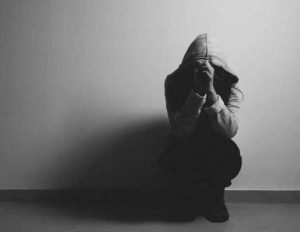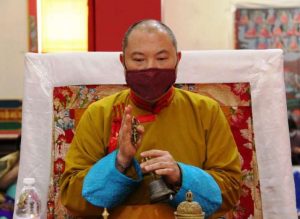
The 18th Sakyadhita International Conference was recently held in Seoul under the theme “Living in a Precarious World: Impermanence, Resilience, Awakening.” From on 23–27 June, more than 3,000 Buddhist monastics, laywomen, guests, and dignitaries from South Korea and around the world gathered to share their experiences and research, and to provide support and encouragement for projects and initiatives to improve the lives of Buddhist women. The five-day forum provided an opportunity to touch bases with old friends from around the world, to forge new connections, to learn and to exchange ideas, to inspire and to be inspired.1
BDG was privileged to attend this unique manifestation of the sacred feminine in contemporary Buddhism, and to meet some of the women who are working to shape the face of Buddhism today. Among the many remarkable female monastics and leaders attending this forum was Gelongma Pema Deki, who has been a prominent and sometimes high-profile figure for her role and participation in the re-establishment of the bhikshuni sangha in the Himalayan Kingdom of Bhutan.
Born Emma Slade, the eldest of three children, to a middle class family in Kent, England, Gelongma Pema Deki’s path has been one of unusual challenges and rare opportunities that eventually led to her becoming one among 142 female monastics to receive full ordination at a milestone ceremony in Bhutan in June 2022.2 Organized by the Bhutan Nuns Foundation, this was a historic step toward realizing greater equality within the monastic institutions of Buddhism in the world’s last remaining country with an unbroken Vajrayana tradition.
In 2015, she founded the charity Opening Your Heart to Bhutan, which works to help improve the lives of the Himalayan kingdom’s most vulnerable children.
Her book, Set Free: A Life-Changing Journey from Banking to Buddhism in Bhutan (2017), traces an intimate and sometimes traumatic account of her journey from the halls of capitalism and investment banking in Hong Kong (also home to the offices of BDG), to encountering the Buddhadharma, and eventually to Bhutan, where a chance meeting led to her studying under a lama and becoming the first Western woman to be fully ordained in the Drukpa Kagyu lineage of Bhutan.

BDG: You mentioned at the conference that you had never intended to become a monastic. What circumstances brought you to that decision?
Gelongma Pema Deki: It’s very true that I never thought I’d be a monastic, but saying that, I’m not surprised that I am. There were many signs that, if I look back over my life now, I can see—I mean, I shaved my head when I was about 20, just feeling a compelling wish to do so, which really shocked my parents. And my interest in Buddhism was there from a very early age.
It wasn’t even really my decision to become a monastic, which might sound rather strange. It was my Lama’s instructions to me to become a monastic and it wasn’t a debate. At the end of 2012, Lama said to me, “Now, you change your dress.” Just like that, out of the blue. And I was like, “Sorry? Sorry, Lama?” And he said, “Yes. Now you change your dress.” And I began to cry. It was just one of those moments, you know, when somebody sees something in you that you can’t see yourself, and feels strongly enough about it to tell you to become a monastic. A strange moment.
At first, I thought that perhaps I’d misunderstood him and that he’d meant something else. I spoke to a friend in Bhutan, who told me, “No, no, he just means that you receive that stripy pinafore that Tibetan women wear.” And then I thought that I’d misunderstood Lama completely . . . I’d thought that this was a really profound moment, but it wasn’t a profound moment. It was merely about a pinafore. So just to be sure, I phoned my teacher up and I said, “Lama, can I just check what it is you want me to do here?” And he said, “Go to the monk shop and buy the robe of an ani, OK? And he was quite short about it! I knew then that I hadn’t misunderstood and that he really did wish me to do this.
At times since, I’ve thought to myself, “Should there have been more of a discussion? Should there have been more of a debate?” But it was just like that. I often meet Western people who are thinking about becoming a monastic, and their mind goes round and round, and they think about it for many years, and there’s a real internal conflict while they weigh things up, and think about pensions and any number of mundane matters. I didn’t have any of those obstacles to overcome because I hadn’t really considered the matter, then Lama told me to do it and so there we go! I was 45 years old at the time.
BDG: So you had already been practicing for quite some time?
GPD: Yes. Earlier in my life, I’d had a child. I’ve never been married, but I had a child. And that was one of the big reasons why I never considered that it would be possible for me to become a monastic. Yet Lama felt very strongly that this was the right thing to do. I can share with you that I heard later from other people about some things he’d said about me that he’s never told me directly, because that’s how Bhutan works. They said that he’d had a vision of me standing outside my own temple that I was in charge of, and when he had that vision he felt that he must tell me to be ordained. But he’s never told me this directly; he only told other people! From my perspective, it did feel like it came out of nowhere, but of course he had some insight on the matter. And of course he was right.
That was about 12 years ago now, I think? So I lived under vows for two years, and then in 2014, I took my getsulma [novice] vows with His Eminence the Dorje Lopen of Bhutan, 3 in Punakha Dzong, which is quite a terrifying experience in terms of the Tibetan words, and so on. We went into Dorje Lopen’s quarters and I sat down. Lama was translating at that point, and Dorje Lopen said some things, and Lama explained: “Dorje Lopen says that he’s never ordained a female before.” When Lama asked for this, at first Dorje Lopen refused, but Lama insisted, “No, she’s a really good practitioner. She will keep the vows. Please, ordain her.” So I believe that I’m the first female to whom Dorje Lopen ever gave getsulma vows. When Lama explained that, I felt a bit apprehensive . . . this is quite a responsibility! Someone says I’ve never ordained a woman before, and then Lama has had the courage and conviction to say I would keep the vows, that I was a good practitioner! He basically went to bat for me, which was very moving.
And then, last year, after many years of practice, I was, extraordinarily, allowed to be the only Western woman to be fully ordained in Bhutan. My teacher now is His Eminence the Dorje Lopen—the person who ordained me is now my teacher. And I think that because I’m his student, it was possible for me to join that ordination process , which it was mainly for Himalayan nuns.
BDG: How long had you been in Bhutan before all of this happened?
GPD: I’d known Lama for about a year at that stage, and Lama had given me many things to do, and I’d done them all, which I think really surprised him. And so I think that because of all of those things he had the measure of me, as they say. But there was two years of, you know, having your head shaved and practicing and wearing robes, and all that sort of thing before the getsulma ceremony in Punakha Dzong.

BDG: What was your perspective after finally taking those bhikshuni vows last year and looking toward the future?
GPD: I mean, the bhikshuni vows in Bhutan was an incredible thing. It’s really hard to put into words. Up until that point in the Himalayas, female Vajrayana practitioners who wanted to be fully ordained had to do so in another tradition—they had to go to Taiwan or to China or somewhere like that. So this is the first time in the Himalayan tradition that they could be ordained there, so this was really a truly historic event.
I think there is a great impact for females in the Himalayas. Prior to that, largely speaking—there were exceptions—but largely speaking the most they could attain was novice vows. And a situation like that does create a certain landscape and a certain mindset; it definitely builds a ceiling. And I think that the ordination ceremony last year really did lift that ceiling in terms of how people are going to view female monastics, and also in terms of how we look at ourselves.
It definitely felt as if those vows opened up a space for us, you know, literally a space was created in which we can continue to make progress and be allowed to practice and be included in practices, in which previously we weren’t. For example, the summer rains retreat took place that summer in Bhutan with the nuns for the first time ever. And in terms of how it feels to receive that higher ordination, it feels very supportive, it feels, personally, that it gives us a great sense of stability of mind that’s a little hard to explain. But somehow, with the higher ordination, you feel very certain, which has been so helpful.
BDG: What sort of responses have you seen among laypeople in Bhutan since the ordination ceremony?
GPD: I think that change is taking place, although there are still some steps to go. It’s a big change after such a long period of time. In most Buddhist countries, people say, it’s very difficult to distinguish between Buddhism and the local culture. So the way people behave in relation to this situation is kind of an intersection between Buddhism and the country’s culture, which has many aspects to it. So we’re seen some change, but I think there’ll be a lot more to come.
BDG: What sort of work are you involved in now?
GPD: Opening Your Heart to Bhutan, my charity, is based in the UK but works exclusively in Bhutan. We mainly help children with special needs and children in very difficult circumstances with education, medicine, and shelter. Those are our areas. And we’ve played a large role in establishing a purpose-built school for special-needs children, in collaboration with charitable organizations in Bhutan, which we work alongside.
Then I guess there’s my own path as a practitioner and as a teacher, also helping with translating and editing texts, my shedra studies—various Buddhist philosophical studies and so on. I have that path, which I’m following.
In terms of my role in female monasticism, I think I’ve always been aware that it’s hard to find inspiring female role models in the modern Buddhist world. They are somewhat rare. Even when we look back at history, they are not often talked about. So I often feel, at least in terms of my own path, that I hope it’s a good example for others. As a Western woman educated in the West, with a certain kind of confidence, I don’t mind being a little confident because I think there’s much to be done in this area. Greater visibility for female practitioners is very much needed. They are just invisible for so much of the time, in the culture, in the iconography, in the texts, in the biographies . . . we need to be more visible.
And I think that we tend to have a sense of our own personal path, of being—I hate the word role model . . . you just have an awareness that you have an ordained female body, you have a duty to conduct yourself properly, to behave as well as you can, to be as good of an example as you can, because in this process of raising respect for female practitioners, we need to be good and we need to be seen to be good.

BDG: How long have you been involved with Sakyadhita?
GPD: I went to Sakyadhita Hong Kong in 2017, and I went to Sakyadhita Australia in 2019, where I talked about my book and my journey to becoming a Buddhist nun. And now I’m here in South Korea, where we gave a presentation on female ordination in Bhutan. That’s three altogether. And I love this one in South Korea, I think it’s been extraordinary for so many different reasons. The example shown by South Korean nuns has been incredibly inspiring. And I think they did such an outstanding job of organizing the whole thing.
This time, I was able to catch up with a Korean friend that I made during the Australian conference, and another friend from the Hong Kong Sakyadhita. So if you come to more than one, you definitely start to make friendships which you can pick up each time, and that is really really nice.
The organization does seem to be strengthening and growing each year. Yet, in a strange way, I wish that more men came to Sakyadhita. Sometimes, when you hear the voices of women explaining their situations and the difficulties they’ve gone through to obtain teachings or recognition or temples and so on, it’s really heartfelt and you feel a camaraderie with them and huge respect for them. But sometimes I’d like more male participants to hear the voices of these women. Although it’s wonderful having this as largely a female gathering, and very unusual in our world, I just don’t know how well the male sangha really understands the situation of the female sangha a lot of the time. And so some dialogue or some listening to each other, I think, could be important.
I think the main thing is that while you’re going to hear a lot about the difficulties of female practitioners, I think there is a very important underlying point: in the modern world, the fourfold sangha does not exist in many places. That is a huge difference from the time of the Buddha. And it’s not a good thing. Because Shakyamuni Buddha said that what is necessary is the fourfold sangha: male monastics, female monastic, laymen and laywomen. Thailand doesn’t quite have it . . . Bhutan now has it a little bit. But just look around the Buddhist world. If the Buddha said we need the fourfold sangha, then I think, in my small, English, female way, that the Buddhist world should be working to make that come alive in all Buddhist countries. It’s not complicated! But it’s not here in this modern world, it’s not here. And we can find many reasons for that: you can say this and that, and blah blah blah. But the Buddha said that we need the fourfold sangha for Buddhism to thrive. So how can Buddhism thrive without the fourfold sangha?
This should be our priority to build, I believe. And if we don’t, then I don’t think that we are serving the Buddhadharma as we should. If we could just clear the slate and say: okay, this is what the Buddha said we should establish, and adjust all work toward that, how different it would be! How many of these silly games that are being played would dissolve! We would come together with a common goal in all Buddhist countries to establish the fourfold sangha!
BDG: Gelongma Pema Deki, thank you so much for sharing your time with us.
The Sakyadhita International Association of Buddhist Women is the world’s leading body committed to transforming the lives of women in Buddhist societies, aspiring to empower and unite Buddhist women, promote their welfare, and facilitate their work for the benefit of the Dharma and all sentient beings. “Sakyadhita” means Daughter of Shakya (the clan name of the historical Buddha). Working at the grassroots level, Sakyadhita provides an international network among Buddhist women, promoting research and publications and striving to create equal opportunities for women in all Buddhist traditions.
1 Daughters of the Buddha: 18th Sakyadhita Conference in Seoul Celebrates the Sacred Feminine (BDG)
2 Gelongma Dompa (dgeslongma’i sdom pa): The Blessing of Bhikshuni Ordination in Bhutan (BDG) and 142 Buddhist Nuns Receive Full Ordination at Landmark Ceremony in Bhutan (BDG)
3 The Dorji Lopen is the most senior of the five Lopens in Bhutan’s central monastic authority, the Zhung Dratshang.
See more
18th Sakyadhita International Conference: Living in a Precarious World: Impermanence, Resilience, Awakening
Sakyadhita International Association of Buddhist Women
Emma Slade | Lopen Ani Pema Deki
Opening Your Heart to Bhutan
Bhutan Nuns Foundation
Related features from BDG
Daughters of the Buddha: Progress on the Path of Female Ordination – A Conversation with Ven. Dhammananda Bhikkhuni
Daughters of the Buddha: Buddhism and Film with Ven. Daehae Sunim
Daughters of the Buddha: 18th Sakyadhita Conference in Seoul Celebrates the Sacred Feminine
From Bangladesh to Korea: Struggles and Successes on the Path to Female Monasticism
From Bhutan to Korea: Reflections of a Female Monastic on the Buddhist Path
Buddhistdoor View: Experiencing the Phase Shift – Women in Buddhism Today
Related news reports from BDG
Tibetan Nuns Project Announces a Record Number of Buddhist Nuns Taking Geshema Examinations in Dharamsala This Year
Engaged Buddhism: INEB Hosts Landmark Interfaith Gathering in Bangkok for Gender Equality and Social Justice
Living in a Precarious World: 18th Sakyadhita Conference Commences in Seoul













